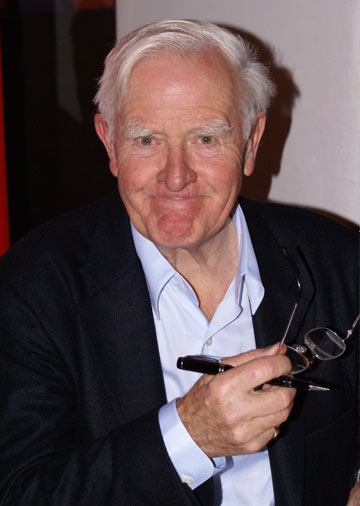
John le Carré: Remembering a Legend
- Celebs
- |
- 28 December 2020
- Kishan S Rana
Evoking the memory of the late John le Carré, maestro of the spy novel, here is a review of his ‘Pigeon Tunnel: Stories from My Life’ crypto-memoir. This book narrates the back story of many of his classics and their characters.
 John le Carré in 2008. Photo courtesy Wikimedia Commons, https://en.wikipedia.org/wiki/GNU_ Free_Documentation_License
John le Carré in 2008. Photo courtesy Wikimedia Commons, https://en.wikipedia.org/wiki/GNU_ Free_Documentation_License
After getting this book from Amazon, I put it aside, put off by a brief comment somewhere calling it a re-heated presentation of characters that traipse through this author’s celebrated works. Recently, casting about for a late night read, I was captivated by a chapter opened random.
John le Carré says in the Introduction: ‘These are true stories told from memory – to which you are entitled to ask, what is truth, and what is memory to a creative writer in what we may delicately call the evening of his life? To the lawyer truth is facts unadorned. Whether such facts are ever findable is another matter. To the creative writer, fact is raw material, not his taskmaster but his instrument, and his job is to make it sing. Real truth lies, if anywhere, not in facts, but nuance.’
Many of the 38 chapters, some very short, present us with old friends from le Carré’s many works. We learn that the good guys are drawn often from real people he admired, which he presented with an author’s freedom to mix and match. George Smiley was inspired in part by an iconic teacher and shaped his early life, but some of Smiley’s traits come from another person that Carré encountered on Fleet Street. Yuvette Pietpaoli, whose heroic life-saving actions for children and women in Phnom Penh at the Khmer Rouge takeover and elsewhere, are exquisitely narrated with love; she provided the inspiration for Tessa Quayle, the central figure whose mysterious murder sets her diplomat-husband on his search in The Constant Gardner (2001), set in Kenya. As for the anti-heroes, le Carré often disguises them; ‘The main player may be dead, but his heirs and assigns may not see the joke.’ Whence this book’s title? Please read the short preface for that allusion, suggesting that we are all creatures of imprinted habit.
Le Carré honed his writing skills during three years with MI5 (domestic intelligence, security, akin to our IB). His classically educated senior officers ‘seized on my reports with gleeful pedantry, heaping contempt on my dangling clauses and gratuitous adverbs, scoring the margins of my deathless prose…’ He then moved to MI6 (external intelligence, like RAW), and was assigned for four years to the embassy in Bonn, shifting later to the consulate-general in Hamburg. With the runway success of his first book, The Spy Who Came in from the Cold (1963) he became a fulltime author.
It was in 1974, visiting Hong Kong that he discovered a small flaw in Tinker Tailor Soldier Spy, then under print; describing that setting he failed to note that the island was linked to Kowloon by a newly commissioned undersea tunnel. That prompted him to travel across the globe’s trouble spots, starting with Cambodia, in a quest for contextual background for his novels, which have given such edge, even immediacy, to his writing. That authenticity became his hallmark.
The book is studded with gems. Among them, his invitation to lunch with the Italian President at the presidential palace, the Qurinale, in Rome; what followed borders on the absurd, but with a biting edge. He received repeated offers from Prime Minister Margaret Thatcher’s staff of an award, turned down with matching firmness (‘…I was not cut out for the honours system, it represents much of what I dislike most about our country…’). That produced a lunch invitation from 10 Downing Street, where he found himself seated to the PM’s left, while on the other side sat the Dutch Prime Minister. That produced a conversation that is both hilarious and poignant, the latter in response to le Carré’s advocacy of the plight of the Palestinian refugees, and Mrs T’s scathing, cutting reply.
Some of the chapters evoke a sense of access to a treasure trove. The why and how of The Tailor of Panama is one example, the rationale for choosing that profession for the central character, and the person that provided the model. Or better, how the inspiration for Alec Leamas, The Spy Who Came in from the Cold came from an airport bar encounter ‘when a stocky man in his forties flopped on a bar stool besides me, delved in his raincoat pocket and poured a handful of loose change in half-a-dozen currencies on the bar. With a fighter’s thick hands he raked through the coins till he had enough of one currency. “Large scotch” he ordered. “No bloody ice”.’
Le Carré is at pains to point out – repeatedly in the book – that he has given away nothing of the real tradecraft of the spy and the counterspy, both in his direct if limited experience. In one moving story, heavily disguised, he pays tribute to someone in a minor role as a member of the British communist party spent a lifetime as an MI5 mole, gathering nothing of worth, paid in pennies, driven by a conviction that he and his wife were sentinels against a potential Soviet takeover of their homeland. It was le Carré’s skill in walking the tightrope between authenticity and camouflage of the real that preserved his access in the British secret services – though not all his colleagues absolved him of professional betrayal.
In essence, le Carré’s background as a spy and the reality-myth roots of his writing locate him at an interstice between a very harsh real world of the secret services, and exuberant fiction. His quest for the authentic, leading to pursuit of the world’s trouble spots have produced lapidary insights that he hoards for his readers. That in turn brought him to the personal attention of the very real world of spymasters and their political leaders. Some engaged with him to seek solutions to their own dilemmas, which in turn furnished more material for this creative author.
The book is an extraordinary read.
Kishan S Rana is a former ambassador, professor, and author. You can contact him at kishanrana@gmail.com
FOLLOW US ON INSTAGRAM

Lifestyle Insider is a kind of junction point, connecting people with diverse interests that touch on the more luxurious aspects of lifestyle – fashion, design, travel, food and spirits, art, watches and jewellery, cars, yachts, and aviation, and technology. People today don’t fit into boxes and categories. In our individual ways, we are interested in diverse themes, products, and the challenges that face our world today. You will judge how well this effort of mine caters to your passions and proclivities.
Lifestyle Insider is a showcase of all that is beautiful and luxe. Behind every creation, is a designer, chef, entrepreneur, or a design maison. I have delved into my own appreciation for objetsde luxe that I have admired over the years – be it a love of fashion from the world’s top Parisian and Italian fashion maisons and their ’90s muses, or the care that goes into sari and Indian textile collections in my own family. Growing up on four continents, as the daughter of a former Indian Ambassador, I’ve seen a remarkable array of historic places and met a myriad people. My aim is to bring my world view into this website, a curation of what I find particularly stunning, unique, and newsworthy.
It’s an exciting time for brands all over the world. With change comes opportunity. With the global ‘reset’ and uncertainty on many fronts, there is a chance to write a new script. Let’s be those pioneers.
A bit about me:
A luxury and fashion journalist with 25 years of experience in publishing and magazine journalism, I have edited some of India’s top fashion and luxury magazines. I got my BA in Comparative Literature from UC Berkeley, and went on to receive my Master’s in English and French from the University of Strasbourg, France. I have also studied German and Film. I live in Gurugram, India, and look forward to once again exploring our world with a new-found freedom.
Priya Kumari Rana
Founder and EditorContact Us
Mail us @ lifestyleinsiderindia@gmail.com

